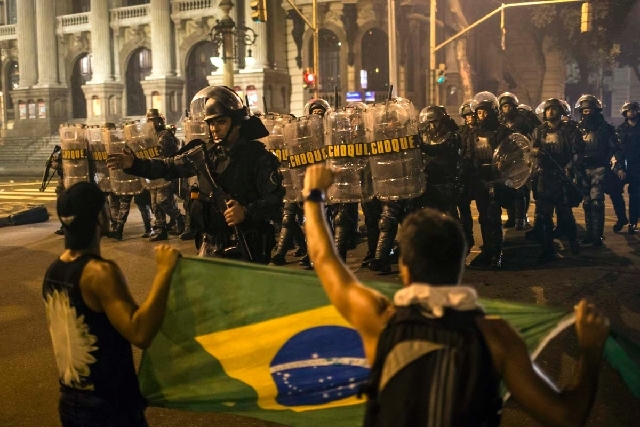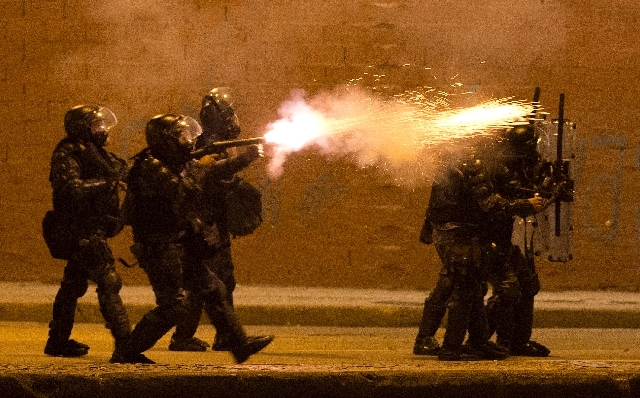Brazil leaders to meet as protests, violence grow





RIO DE JANEIRO — Brazil awoke Friday to city centers still smoldering after a night that shocked the nation: 1 million protesters took to the streets in scores of cities, with clusters clashing violently with police during anti-government demonstrations.
President Dilma Rousseff, a standoffish leader who has been virtually mute in the face of the most violent protests in recent memory, called a meeting with top Cabinet members. She faced sharp criticism in Brazil’s media for what many called her lack of any leadership.
It was not clear what action her government might take or if she would appear before the nation to give an address. There were growing calls on social media and in emails for a general strike next week.
Standing before the battered government building he presides over, Foreign Minister Antonio Patriota said he “was very angry” that protesters attacked a structure “that represents the search for understanding through dialogue.” Patriota called for protesters “to convey their demands peacefully”
“I believe that the great majority of the protesters are not taking part in this violence and are instead looking to improve Brazil’s democracy via legitimate forms of protest,” Patriota said.
Despite the violence, the majority of protesters have been peaceful. In massive demonstrations through this week, as small groups began to vandalize, crowds would often turn and start to chant, “No violence! No violence!”
But the pattern in cities across this continent-sized nation has been that once night falls, the violence begins. Protesters and police clashed in several cities into the early hours Friday, as people vented anger over a litany of complaints, from high taxes to corruption to rising prices.
At least one protester was killed in Sao Paulo state when a car rammed into a crowd of demonstrators after the driver apparently became enraged about being unable to drive along a street.
In Rio de Janeiro, where an estimated 300,000 demonstrators poured into the seaside city’s central area, running clashes played out between riot police and clusters of mostly young men with T-shirts wrapped around their faces. But peaceful protesters were caught up in the fray, too, as police fired tear gas canisters into their midst and at times indiscriminately used pepper spray.
Thundering booms echoed off stately colonial buildings as rubber bullets and gas were fired at fleeing crowds.
At least 40 people were injured in Rio, including protesters like Michele Menezes, a wisp of a woman whose youthful face and braces belie her 26 years. Bleeding and with her hair singed from the explosion of a tear gas canister, she said she and others took refuge from the violence in an open bar, only to have a police officer toss the canister inside.
The blast ripped through Menezes’ jeans, tearing two coin-sized holes on the back of her thighs, and peppered her upper arm with a rash of small holes.
“I was leaving a peaceful protest and it’s not the thugs that attack me but the police themselves,” said Menezes, removing her wire-rim glasses to wipe her bloodshot eyes.
She later took refuge in a hotel, along with about two dozen youths, families and others who said they had been repeatedly hit with pepper spray by motorcycle police as they also sheltered inside a bar.
Protesters said they would not back down.
“I saw some pretty scary things, but they’re not going to shake me. There’s another march on the 22nd and I’m going to be there,” said 19-year-old university student Fernanda Szuster.
Asked if her parents knew she was joining in the protests, Szuster said: “They know and they’re proud. They also protested when they were young. So they think it’s great.”
She added, though, that she wouldn’t tell her father the details of the police violence. “If he knew, he would never let me leave the house again.”
In Brasilia, the national capital, police struggled to keep hundreds of protesters from invading the Foreign Ministry and the crowd set a small fire outside. Other government buildings were attacked around the city’s central esplanade. There, too, police used tear gas and rubber bullets trying to scatter demonstrators.
Clashes were also reported in the Amazon jungle city of Belem, Porto Alegre in the south, the university town Campinas north of Sao Paulo and the northeastern city of Salvador.
“This was meant to be a peaceful demonstration and it is,” artist Wanderlei Costa, 33, said in Brasilia. “It’s a shame some people cause trouble when there is a much bigger message behind this movement. Brazil needs to change, not only on the government level, but also on the grass-roots level. We have to learn to demonstrate without violence.”
The protests took place one week after a violent police crackdown on a much smaller demonstration against an increase in bus and subway fares in Sao Paulo galvanized Brazilians to take their grievances to the streets.
The unrest is hitting the nation as it hosts the Confederations Cup soccer tournament, with tens of thousands of foreign visitors in attendance. It also comes one month before Pope Francis is scheduled to visit Brazil, and ahead of the 2014 World Cup and 2016 Olympics, raising concerns about how Brazilian officials will provide security.
Mass protests have been rare in this country of 190 million people in recent years, and the mushrooming demonstrations of the past week caught Brazilian government officials by surprise while delighting many citizens.
“I think we desperately need this, that we’ve been needing this for a very, very long time,” said Paulo Roberto Rodrigues da Cunha, a 63-year-old clothing store salesman in Rio.
Despite the energy on the street, many protesters said they were unsure how the movement would win real political concessions. People in the protests have held up signs asking for everything from education reforms to free bus fares while denouncing the billions of public dollars spent on stadiums in advance of the World Cup and the Olympics.
“We pay a lot of money in taxes, for electricity, for services, and we want to know where that money is,” said Italo Santos, a 25-year old student who joined a rally by 5,000 protesters at Salvador’s Campo Grand Square.
“This is the start of a structural change in Brazil,” said Aline Campos, a 29-year-old publicist in Brasilia. “People now want to make sure their money is well spent, that it’s not wasted through corruption.”
—
Brooks reported from Sao Paulo. Associated Press writers Marco Sibaja in Brasilia, Stan Lehman in Sao Paulo and Ricardo Zuniga in Salvador contributed to this report.













